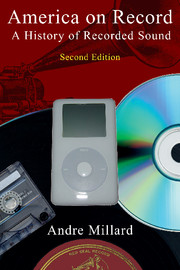Book contents
- Frontmatter
- Dedication
- Contents
- Preface to the second edition
- Preface to the first edition
- Introduction
- Part One The acoustic era
- Part Two The electrical era
- 6 The machines
- 7 Competing technologies
- 8 Empires of sound
- 9 Swing and the mass audience
- 10 High fidelity at last
- 11 Rock'n'roll and the revolution in music
- 12 The record
- 13 The studio
- 14 Perfecting studio recording
- 15 The cassette culture
- Part Three The digital era
- Abbreviations used in the notes
- Notes
- Select discography
- Select bibliography
- Subject index
- Recordings index
- Motion picture index
14 - Perfecting studio recording
from Part Two - The electrical era
Published online by Cambridge University Press: 05 February 2015
- Frontmatter
- Dedication
- Contents
- Preface to the second edition
- Preface to the first edition
- Introduction
- Part One The acoustic era
- Part Two The electrical era
- 6 The machines
- 7 Competing technologies
- 8 Empires of sound
- 9 Swing and the mass audience
- 10 High fidelity at last
- 11 Rock'n'roll and the revolution in music
- 12 The record
- 13 The studio
- 14 Perfecting studio recording
- 15 The cassette culture
- Part Three The digital era
- Abbreviations used in the notes
- Notes
- Select discography
- Select bibliography
- Subject index
- Recordings index
- Motion picture index
Summary
Diffusion of recording techniques from sound stages to the studios of the record companies was slow. The first time that several microphones were used to record a large group of musicians was in 1926 in the Metropolitan Opera House in New York to make synchronized recordings for Vitaphone films. Engineers from the Victor Company thought that one microphone placed in the auditorium was best, but the Vitaphone recorders wanted to use six: one each for strings, brass, woodwinds, basses, and percussion, and one for the overall sound. They made a recording of each setup and compared the two. There was no doubt that the multi-microphone technique produced clearer and more lifelike sound.
This test did not lead to general use of multiple microphones in the recording industry; common practice in the 1930s was to place one microphone above the musicians. The transition to multi-miking came slowly. At first engineers employed two microphones for large groups and orchestras, one at the front and one at the back. Later they added other microphones to pick up the bass section or the soloists. This procedure was established in the large recording studios by the end of the 1930s, but recorders in smaller studios still used one or two microphones.
Studio recorders did not attempt to create several tracks of a recording and mix them together; and actually the single microphone recording can bring out all the sounds of a large orchestra. Benny Goodman's historic Carnegie Hall concert of 1938, for example, was recorded by one microphone over the band, which conveyed its sound to the CBS studios for transcription. The emphasis in the record business was on the realistic reproduction of a live performance, and once the recording had been made, there was little thought of altering it in any way to make it sound better.
Although the technique of re-recording was not unknown to the engineers in record studios, it was very rarely employed by them in the 1930s.
- Type
- Chapter
- Information
- America on RecordA History of Recorded Sound, pp. 285 - 312Publisher: Cambridge University PressPrint publication year: 2005



